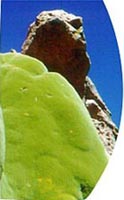The San Pedro Oasis
In 1557 the Spaniards founded a mission with a chapel on the banks of the San Pedro
river at 2,445 meters above sea level. With the largest population in the Atacama, it
became the administration center for the Spaniards. To the North lies the Pampa del
Tamarugal, to the East, the Altiplano and the Cordillera de los Andes, the Salar de
Atacama and the Cordillera de Domeyko to the south, and to the west, the Pampa, the
Cordillera de la Costa and the Pacific Ocean.
The area is characterized by blue skies and mild temperatures throughout the year. The
Atacama Desert has a continental climate with temperatures that range from 86 degrees F
during the day to 32 degrees F at night. In San Pedro de Atacama, the average winter
temperature is 71 degrees F during the day and 39 degrees F at night. During the summer,
temperatures range from 80 degrees during the day to 60 degrees at night. There may be
some light rain.
 The Sierra, or mountain area has a transition climate with
average temperatures of 68 degrees F in the summer and 48 degrees in the winter. There is
a chance of rain during the summer. The Sierra, or mountain area has a transition climate with
average temperatures of 68 degrees F in the summer and 48 degrees in the winter. There is
a chance of rain during the summer.
The Altiplano is a highland steppe with average temperatures ranging from 50 degrees F
to 23 degrees. During the winter, there are rains and snowfall.
Flora and Fauna
The llama , alpaca, guanaco and vicuņa, all part of the camel family are
indigenous to the region. Flamingoes are also seen year round. Cacti
represents the most common vegetation.
Access
Via Santiago de Chile / Calama. There are daily flights on several
airlines. The flights are approx. 2 hours and 50 minutes. From Calama to San
Pedro de Atacama there is a 103 km. ride over paved roads.
|